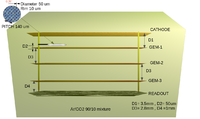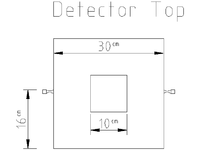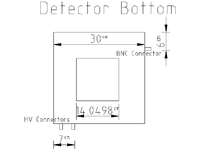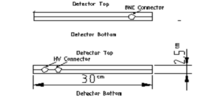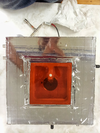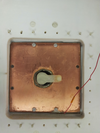Detector Description
GEM Detector Design
You should first describe the basics of the gas electron multiplier then describe the ionization chamber equipped with GEM foils, then describe the assembly in a clean room environment.
GEM detector has been designed, developed and used for detection in CERN since 1997. Gandi and De Oliveira were the first who designed GEM preamplifiers, the deign was on 55 um kipton copper clad cards, they had holes of 70 um in diameter in a an equilateral triangular pattern with a 140 um pitch distance. A single GEm preamplifier may an electron multiplication up to , but Adding a rim of 10um for each hole and increasing the number of cards to three GEM cards increase the multiplication to .
Clean Environment
Gaseous detectors, like most detectors, are constructed in environments that minimize the presence of contaminants. Most of the methods for detector construction and maintenance demand a clean environment. Generally, clean environments are classified depending on the size and the number of existing particulates in the room; each class maintains its environment by filtering the air that enters the room, by keeping air circulation in a specific rate, and by using soft or hard walls that isolate the room from the surrounding environment. Clean rooms have restrictions on the type of materials for the equipment and furniture, and have special instructions for the workers who can carry contaminants: the workers have to use gloves, hats, pants, shoes, and gowns that are designed for this purpose. Laminar hoods are another method to get a clean environment: they are easy to maintain, have less restrictions to keep them clean,and usually provide enough space for building and maintaining small size detectors.
Detector Structure
You should describe the features of the detector using a paragraph and not an enumerated list.
First start with a description of the GEM foil and how the strong electric fields cause secondary ionization
After that you describe using several of the foils to further multiply the signal and introduce the anode and cathode to direct ionized electrons through the three amplification stages.
Finally you can describe the HV network used to supply a voltage to all the components and the ionization chamber which immerses them in the Ar/Co2 gas.
The triple GEM detector is based on three GEM preamplifiers, a cathode and an anode. The GEM preamplifier is made of a copper-clad kipton plate which is 50 um thick and has an area of 10x10cm, it has holes that are chemically etched with a diameter of 50 um with a 10um rim. The holes have a an equilateral triangular pattern with a 140 um pitch distance. The detector possesses three GEM cards in square plastic frames, they are placed parallel to the cathode and are separated by a vertical distance of 2.8 mm as shown in the figure below.
The cathode is a square copper plate that is a 10x10cm and has a distance of 3.5 mm from the top of the first GEM card. This cathode design allows a rise in potential on its surface up to 5 kV (in the air) without any discharge effect.The charge collector (readout anode) is constructed of 50-80 micron wide strips and are insulated to determine the location of the collected electrons. They are arranged to give equal charge sharing on the charge collector.
All the previous components exist in a sealed chamber that consists of two ertalyte plastic sheets; they are bolted together by a number of M3 plastic screws located around the detector window to form a well enclosed cavity. Also, the chamber has a 13x13cm kipton window for incident particles.The figures below show top, bottom and side view of the detector's chamber design.
Modifying the GEM detector as neutron sensitive detector
The GEM’s original design was modified to convert it to a neutron sensitive detector. The cathode design has a 3 cm diameter coating, and 40-50 um thickness. The kepton window had an increase in height of 2.5 mm, which helped to increase the distance of the cathode to 8 mm from the top of the first of GEM card (instead of 3.5 mm in the original design). An FR4 shutter was attached in the space between the cathode and the first GEM card, which had enough area to cover the coating area; it has a position controller that helps to open and close the shutter. When the shutter is closed, it covers the U-233 coating and stops the emitted fission fragments from causing ionization in the gas, but when the shutter is open, the ionization of the fission fragments produces a signal that indicates the existence of neutrons inside the chamber which the detector trigger detects for analysis by the DAQ system.
The figures below show the modified components of the detector.
High voltage divider
GEM preamplifiers are connected with high voltage divider circuit. as shown in the figure below:

The circuit provides the cathode with a voltage of 3.6 kV, and it produces an electric field which drifts most of the electrons that are primarily produced by ionization. The circuit also provides the GEM preamplifiers with voltage between the top and bottom of each card; the voltage gradually decreases to have the least value between the sides of the third GEM card. This design's advantage is to provide enough voltage for electron multiplication, and to guide most of the drift electrons to the grounded readout plate.
The following table shows the voltage measurements between the sides of the GEM preamplifiers, and voltage between each side and the ground using the HV-voltage divider circuit shown in figure (2).
| 2550 | 2579 | 2259 | 304 | 1671 | 1394 | 279 | 818 | 570 | 245 |
| 2600 | 2630 | 2303 | 310 | 1704 | 1421 | 285 | 834 | 581 | 250 |
| 2650 | 2680 | 2348 | 316 | 1737 | 1449 | 290 | 850 | 592 | 255 |
| 2700 | 2731 | 2393 | 322 | 1770 | 1476 | 296 | 866 | 603 | 260 |
| 2750 | 2781 | 2373 | 328 | 1803 | 1503 | 302 | 882 | 614 | 264 |
| 2800 | 2832 | 2482 | 332 | 1836 | 1530 | 307 | 898 | 625 | 269 |
Go Back [1]
